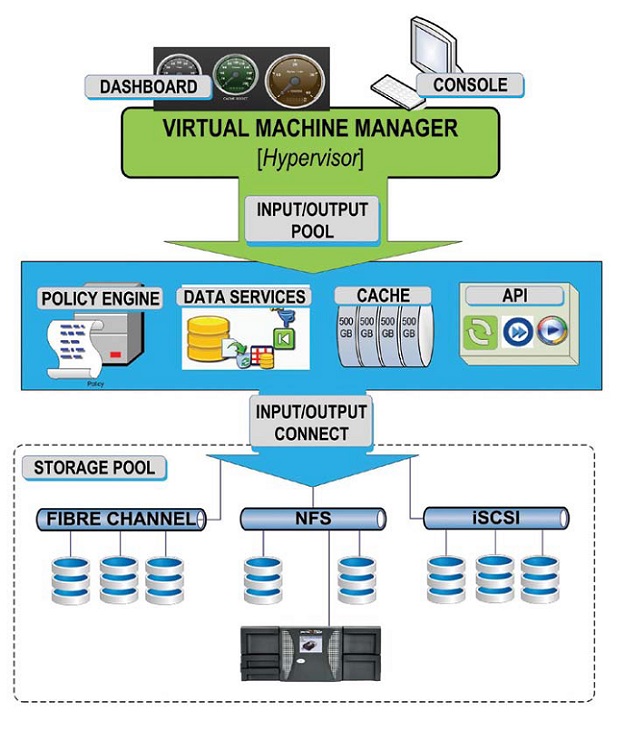Unlocking Software-Defined Storage

Karl Paulsen Just when you thought you’d had your fill of three-letter-acronyms, on comes yet another TLA; this time it’s “SDS” or software-defined storage. While SDS emerged as a data-center/cloudcentric term, its history is straight out of other evolving software-defined systems. As a term, SDS became part of other marketing twists designed to sell products, services and software. No matter what it applies to, “software-defined” seems to be the hot term for what’s new and innovative in the world of information technology.
Our industry is now engulfed in interest over “software-defined networks” (SDN) and rightly so. For broadcasters, the days of point-to-point directed distribution of SDI video appear to be numbered. Not that SDI is vanishing anytime soon; digital video, traditionally confined to the principle implementations of SDI as SMPTE 259, 292 and 424, is now being transformed into a packetized “IT-centric” environment carried over gigabit Ethernet (GbE).

This relatively recent shift revolutionizes how we handle professional video going forward. Changes are well underway at the transport level, the network switching level, and in just the past year or so, new strategies have reached the SDI video-routing level.
If you can wrap your head around packetized video enough to see how it is changing our industry, then extend that thought process to having software managing storage and you’ll see yet another rationale for cloud services. We should make it clear: Software-defined systems need not be relegated only to the cloud.
POINT TO POINT (OR MULTIPOINT)
As SDI-video routers have grown from 256x256 to well above 1156x1156; the costs, complexities, and risks associated with owning and operating large-scale video routers is causing the industry to rethink the value-proposition of plopping down a million bucks for what is essentially a point-to-point/point-to-multipoint, one-way infrastructure. As 10 GbE networking components have accelerated in availability, so have the interfaces that transport video signals over private LAN/ WANs as well as conventional carrier-class global networks. By using cost-efficient, packetized routing, the ability to assemble a software-defined video-routing network with upwards of 13,000 ports is possible, with systems already manufactured by at least one video equipment manufacturer.
Shifting to the world of storage, we see where the dependency on storage systems for the livelihood of our industry continues to be fraught with requirements for higher storage density, better utilization, more sophisticated management and less administrative overhead. This applies not only to the data stored on a given media, but to the devices that serve that data to and from its users as well.
Many issues drove the development of software-defined storage. The fundamental concepts in SDS are derived from virtualization; i.e., the pooling of resources at an abstraction level so as to obtain better efficiencies and common systems management.
SDS is a mature representation of what began as a manufacturer-coined phrase to promote products or exemplify plans. SDS is evolving as part of the industry’s needs to address systems management and operations at a software level, rather than past approaches of continually adding more hardware to address a raft of expanding issues.

Fig. 1: Software-defined system comprised of a hypervisor (virtual machine manager), software-defined storage (SDS) pool, and selected services. The “storage pool” is consists of different forms of networked storage hardware which appear to the system as a single storage element, managed by the policy engine and user console.
In more recent times, the terminology “software-defined data center” (SDDC), was looked upon as an architectural approach to a data storage facility that virtualizes the elements of its own infrastructure. Extending this to storage, SDS provides a common framework for storage allocation by collecting (or pooling) different forms of storage resources and then, by automating many functions, humans are removed from the process of making routine decisions. Thus, storage is thrust into a software-managed domain which essentially becomes what some call “IT as a service.”
Software-defined systems are not always easy concepts to grasp. Conceptually, data centers built as a SDDC will consist of three structures that collectively form the building blocks of an architecture incorporating the virtualization of networks, storage systems and server sets. Storage virtualization, discussed in my Storage Technology column in November 2012 (“Software Defined Systems & Virtualization”), is the management of storage capacity through techniques such as storage resource pooling. Alongside pooling is thin-provisioning, a technique that manages raw workspace and storage to yield improvements in application processing and better utilization of disparate collections of storage devices.
Sometimes thought of as a synonym for storage virtualization, SDS is a data storage management approach that uses programming to control storage-related tasks which are then decoupled from the individual physical storage device (i.e., the hardware) itself. Administrators look at SDS as a management protocol that uses programming to control storage allocation tasks at a much finer, almost granular, level than they could ever do manually. Through user-defined service levels, storage resource administration becomes disconnected from the specifics of the actual hardware. In essence, the administrator no longer needs to think about the hardware aspects of the storage and in turn, the usefulness of the shared pools of storage grows substantially.
MANAGED FROM CENTRAL POINT
Returning to storage virtualization; by collecting the various forms of physical storage as network storage devices (usually a SAN or NAS), and forming them into a homogeneous collection that appears as a single storage device, an SDS platform can then be managed from a central console. This configuration allows the storage administrator to do backup, archive or recovery tasks more efficiently, in less time, and without concern for the various hardware forms of storage in the pool.
Today, managing a virtualized system might employ virtual machine monitoring technology, also known as a “hypervisor.” The term, frequently found attached to trademarked products, may be coupled with storage to form a “storage-hypervisor,” the fundamental principle of the storage-centric term marketed as “software-defined storage.” A storage-hypervisor is a supervisory program that manages multiple pools of storage as virtual resources, effectively treating all storage hardware as generic through the use of abstraction (Fig. 1).
Abstraction is closely coupled to the functionality of storage-hypervisor management methodologies and is the key to making SDS work. In general, abstraction is the process of removing the many characteristics of something (often multiple things) so as to reduce them to only a single set of essential characteristics.
In other words, SDS removes the layers of control, management, or configuration and replaces those functions with software programming that determines what to do with the resources; where, when and how to allocate the storage resource pool; and it does this without the user being aware it is even happening. This is precisely what happens to storage in the cloud, whether as a private/closed-cloud or as a public/commercial cloud-service offering.
We’ve just taken some baby steps to understand the concepts and applications for software-defined storage. In future articles, we’ll take a look at what has become a multi-year crusade to handle the fundamental tasks of storage management, which have become an administrative occupation that is evolving as fast as the demands for increased storage needs.
Karl Paulsen, CPBE and SMPTE Fellow, is the CTO at Diversified Systems. Read more about other storage topics in his current book “Moving Media Storage Technologies.” Contact Karl atkpaulsen@divsystems.com.
Get the TV Tech Newsletter
The professional video industry's #1 source for news, trends and product and tech information. Sign up below.

Karl Paulsen recently retired as a CTO and has regularly contributed to TV Tech on topics related to media, networking, workflow, cloud and systemization for the media and entertainment industry. He is a SMPTE Fellow with more than 50 years of engineering and managerial experience in commercial TV and radio broadcasting. For over 25 years he has written on featured topics in TV Tech magazine—penning the magazine’s “Storage and Media Technologies” and “Cloudspotter’s Journal” columns.
